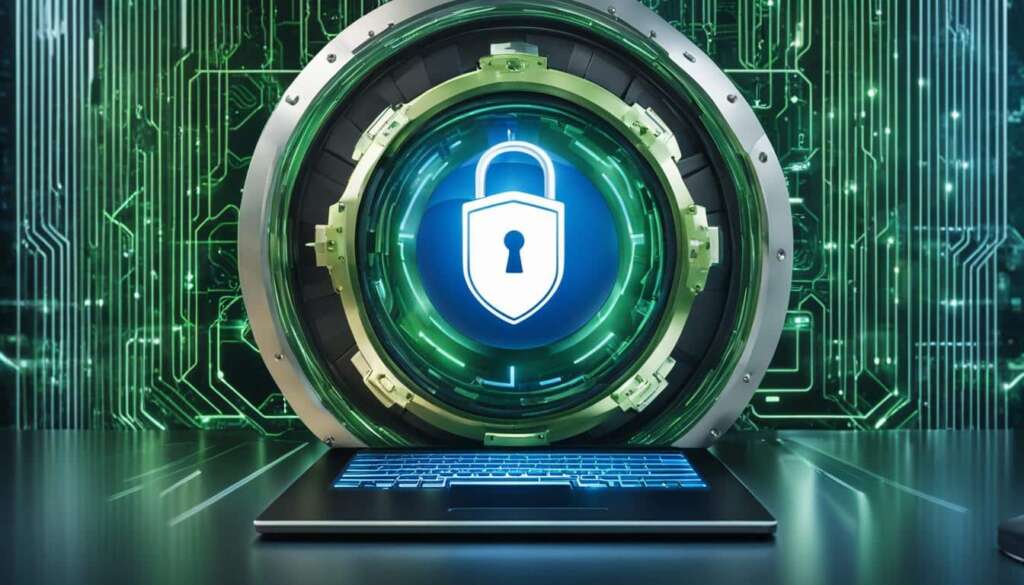Table of Contents
Computer security is of paramount importance in today’s digital age. With the increasing reliance on technology and the rapid advancement of cyber threats, protecting computer systems and sensitive data has become essential. But what exactly is computer security?
In simple terms, computer security refers to the measures and controls put in place to ensure the confidentiality, integrity, and availability of information processed and stored by a computer. It encompasses various aspects, including physical security, data security, and computer safety practices, all aimed at safeguarding against breaches and unauthorized access.
Key Takeaways:
- Computer security is vital to protect sensitive data and prevent cybercrime.
- It includes measures such as physical security, data security, and computer safety practices.
- Installing antivirus software and using strong passwords are basic computer security steps.
- There are various types of computer security, such as application security, information security, network security, and endpoint security.
- Careers in computer security offer promising opportunities in the growing field of cybersecurity.
The Basics of Computer Security
Protecting your computer systems from unauthorized access and ensuring the security of your data is vital in today’s digital world. Basic computer security measures provide a solid foundation for safeguarding personal and business information from cyber threats. By implementing antivirus software, using strong passwords, and practicing safe online behavior, you can significantly enhance the security of your computer systems.
Installing Antivirus Software
One of the fundamental steps in basic computer security is installing reliable antivirus software. Antivirus software helps detect and remove various forms of malware, including viruses, worms, trojan horses, and spyware. It acts as a protective shield against cyber threats that could compromise the confidentiality and integrity of your data.
By regularly updating your antivirus software and performing system scans, you can ensure that your computer is protected against the latest malware threats. Additionally, most antivirus software programs offer real-time protection, actively monitoring your computer for any suspicious activities or attempts to access malicious websites.
Using Strong Passwords
Another essential aspect of basic computer security is using strong passwords. Weak passwords are susceptible to brute-force attacks, where hackers use automated tools to guess your password by trying various combinations. To strengthen your password security:
- Choose long passwords with a mix of uppercase and lowercase letters, numbers, and symbols.
- Avoid using obvious words or personal information that can be easily guessed.
- Use a unique password for each account or website.
- Consider using a password manager to securely store and manage your passwords.
By following these password best practices, you significantly reduce the risk of unauthorized access to your computer systems and sensitive information.
When sharing data online, it is crucial to take additional security measures to protect your information. Here are some practices to consider:
- Encrypt sensitive data before transmitting it over the internet to ensure its confidentiality.
- Be cautious when sharing personal or sensitive information on social media platforms.
- Avoid clicking on suspicious links or downloading files from untrusted sources.
- Regularly backup your data to prevent data loss in case of a security breach.
By being vigilant and adopting these practices, you can minimize the risk of data leaks and unauthorized access when sharing information online.
Remember, basic computer security measures are just the beginning. It is vital to stay up-to-date with the latest security trends and continuously enhance your security practices to effectively mitigate emerging cyber threats.
| Benefits of Basic Computer Security | Actions to Enhance Computer Security |
|---|---|
| Protection against malware | Regularly update antivirus software |
| Prevention of unauthorized access | Use strong, unique passwords |
| Safeguarding sensitive data | Encrypt data before sharing online |
| Promotion of safe online behavior | Avoid clicking on suspicious links |
Types of Computer Security
Computer security encompasses various types, each addressing different aspects of an organization’s digital infrastructure. By implementing these types of computer security, companies can protect against cyber threats and safeguard their sensitive information.
1. Application Security
Application security involves adding features and measures to software systems to prevent cyber threats and vulnerabilities. This includes implementing secure coding practices, performing regular security assessments, and staying up-to-date with security patches and updates.
2. Information Security
Information security focuses on protecting company data assets from unauthorized use, disclosure, alteration, or destruction. This includes implementing access controls, data encryption, and secure data storage solutions to ensure the confidentiality, integrity, and availability of information.
3. Network Security
Network security involves implementing procedures, technologies, and policies to prevent unauthorized access, modification, or exploitation of computer networks. This includes deploying firewalls, intrusion detection and prevention systems, and VPNs to protect against network-based attacks.
4. Endpoint Security
Endpoint security focuses on safeguarding individual devices, such as laptops, desktops, and mobile devices, that are connected to an organization’s network. This includes deploying antivirus software, implementing device encryption, and enforcing strong access control measures to protect against malware, data theft, and unauthorized access.
Each type of computer security requires specialized knowledge and skills to effectively protect against cyber threats. By implementing a comprehensive approach, organizations can enhance their overall security posture and mitigate the risks associated with the evolving threat landscape.
Why is Computer Security Important?
Computer security plays a vital role in today’s digital landscape. With the increasing prevalence of cyber threats, understanding the importance of robust security measures is crucial for individuals and organizations alike. Cybercrime has become a widespread issue, posing significant risks such as data theft, denial of service attacks, and malware dissemination.
Implementing effective computer security practices is essential for mitigating these risks and protecting sensitive information. By prioritizing computer security, individuals and organizations can:
- Prevent Data Breaches: Computer security measures help safeguard sensitive data from unauthorized access and breaches. By implementing encryption protocols, access controls, and secure authentication mechanisms, organizations can minimize the risk of data compromise.
- Protect Against Unauthorized Access: Cyber threats often target vulnerable systems and networks to gain unauthorized access. Robust security measures such as firewalls, intrusion detection systems, and user authentication protocols help thwart unauthorized entry, ensuring the integrity and confidentiality of sensitive information.
- Ensure Continuity and Integrity of Computer Systems: Cyber threats such as malware, viruses, and ransomware can disrupt computer systems and compromise their integrity. Adequate computer security measures, including regular system updates, antivirus software, and system monitoring, help maintain the stability and reliability of computer infrastructure.
“Computer security is not an option; it’s a necessity.”
Implementing effective computer security practices is crucial for mitigating risks and safeguarding data against cyber threats. It is a collective responsibility to prioritize computer security to ensure a safer digital environment for all.
The Consequences of Neglecting Computer Security
Failure to prioritize computer security can have severe consequences. Without robust security measures in place, individuals and organizations risk the following:
- Data Breaches: Lack of proper security controls can lead to unauthorized access and theft of sensitive information. Data breaches can harm an organization’s reputation, result in financial losses, and violate privacy regulations.
- Disruption of Services: Cyber threats such as denial of service (DoS) attacks can cripple computer systems, rendering them unavailable to users. This can lead to significant disruptions in business operations, loss of productivity, and financial implications.
- Spread of Malware: Neglecting computer security can leave systems vulnerable to malware attacks. Malware can compromise data, infect networks, and propagate to other connected devices, potentially causing extensive damage.
Illustrative Example: Breached Organizations
Multiple high-profile breaches have highlighted the importance of computer security. These incidents exemplify the consequences of inadequate security measures:
| Organization | Breach Description |
|---|---|
| SolarWinds | The company’s software supply chain was compromised, resulting in the widespread infiltration of government and private organizations’ networks. |
| Equifax | A data breach exposed sensitive personal information, including Social Security numbers, of millions of individuals. |
| Maersk | A massive cyberattack disrupted the company’s operations, costing them millions in recovery efforts and lost business. |
Careers in Computer Security
The world of computer security offers exciting career prospects, driven by the increasing demand for cybersecurity specialists. As organizations prioritize the protection of their valuable digital assets, the need for skilled professionals in computer security continues to grow. If you have a passion for safeguarding computer systems and networks, a career in this field can be both rewarding and challenging.
Information Security Analysts
Information security analysts play a crucial role in protecting computer networks and systems from potential threats. Their responsibilities include implementing security procedures, identifying vulnerabilities, and monitoring for breach attempts. These professionals work tirelessly to ensure the confidentiality, integrity, and availability of sensitive data. By analyzing security risks and designing effective countermeasures, information security analysts help organizations stay one step ahead of cybercriminals.
Computer Systems Analysts
“The true sign of intelligence is not knowledge, but imagination.”
Computer systems analysts play a crucial role in enhancing the overall security of computer systems. They evaluate the effectiveness of existing security measures, identify potential vulnerabilities, and develop innovative solutions to mitigate risks. By integrating computer systems and assessing security protocols, computer systems analysts ensure that organizations maintain robust defenses against cyber threats. Their expertise in optimizing security configurations and implementing best practices makes them indispensable assets in the fight against cybercrime.
The Rising Tide of Opportunity
- Computer security jobs are on the rise, offering promising career paths for aspiring professionals.
- As technology advancements continue to shape the digital landscape, cybersecurity specialists with comprehensive knowledge and skills are in high demand.
- The increasing prevalence of cyber threats highlights the need for talented individuals who can proactively address emerging risks.
- Careers in computer security provide ample opportunities for personal and professional growth, as well as the chance to make a significant impact in protecting valuable assets.
| Job Title | Key Responsibilities | Skills Required |
|---|---|---|
| Information Security Analyst | – Implementing security procedures – Monitoring for breach attempts – Assessing vulnerabilities |
– Knowledge of cybersecurity principles – Strong analytical and problem-solving skills – Proficiency in network and system security |
| Computer Systems Analyst | – Evaluating existing security measures – Developing security solutions – Assessing system integration |
– Understanding of computer systems architecture – Expertise in cybersecurity best practices – Abilities in risk assessment and mitigation |
Embarking on a career in computer security opens doors to a dynamic and evolving industry. Protecting sensitive information, combating cyber threats, and ensuring the integrity of computer systems are vital contributions to a secure digital environment. Are you ready to be at the forefront of this crucial battle?
Backdoors and Their Impact on Computer Security
A backdoor is a secret method that bypasses normal authentication or security controls in a computer system. These backdoors can be added by authorized parties for legitimate access or by attackers for malicious purposes. Regardless of their origins, backdoors have the potential to compromise the security of a computer system, leading to unauthorized access or manipulation of data.
The Dangers of Backdoors
Backdoors pose significant threats to computer security by exploiting vulnerabilities in system defenses. They provide a surreptitious entry point, allowing unauthorized access without detection. As a result, cybercriminals can infiltrate a system, steal sensitive information, modify data, or even launch further attacks.
Backdoors can be likened to leaving a window or a door unlocked in a home. Even if all other security measures are in place, a backdoor serves as an entry point for potential intruders.
Detecting and Preventing Backdoors
Detecting backdoors can be challenging due to their stealthy nature. However, there are preventive measures that organizations and individuals can take to mitigate the risks associated with these vulnerabilities:
- Regular Security Audits: Conducting routine security audits can help identify potential backdoors or system vulnerabilities.
- Software Updates and Patches: Keeping software up to date with the latest security patches helps minimize the risk of exploiting known vulnerabilities.
- Intrusion Detection Systems (IDS): Implementing IDS can help detect suspicious activities or unauthorized access attempts, including backdoor entry.
By being proactive and implementing robust security measures, organizations and individuals can strengthen their defenses against backdoors and protect their computer systems from potential vulnerabilities.
The Importance of Backdoor Prevention
Preventing backdoors is crucial for maintaining computer security. By eliminating these secret entry points, organizations and individuals can safeguard their systems and data from unauthorized access, manipulation, or theft. Recognizing the potential impact of backdoors highlights the need for constant vigilance and proactive security measures.
It is essential to stay informed about the latest security threats and employ best practices to tackle emerging risks. Additionally, collaborating with cybersecurity professionals and leveraging their expertise can further enhance backdoor prevention efforts.
Denial-of-Service Attacks and Computer Security
Denial-of-service (DoS) attacks are one of the most concerning cyber threats to network security. These attacks are designed to render a machine or network resource unavailable to its intended users, causing service disruptions and potential loss of critical information. Attackers achieve this by overwhelming the targeted system with excessive traffic, depleting its resources and making it unable to handle legitimate requests from users.

One of the variants of DoS attacks is the distributed denial-of-service (DDoS) attack, which amplifies the impact by incorporating multiple systems to simultaneously execute the attack on a single target. These attacks are more coordinated and challenging to mitigate, making network security measures even more crucial.
To combat and mitigate DoS attacks, effective network security measures must be in place. The key to protecting against denial-of-service attacks lies in implementing robust network security protocols, such as firewalls and intrusion prevention systems. These measures work together to inspect and filter incoming traffic, blocking any malicious requests and ensuring the availability of network resources for legitimate users.
By establishing comprehensive network security measures, organizations can minimize the potential impact of denial-of-service attacks, safeguard their systems, and maintain uninterrupted operations.
Eavesdropping and Computer Security
Eavesdropping is a stealthy practice that involves surreptitiously listening to private computer conversations or communications on a network. It is a significant threat to computer security, as attackers can intercept unsecured or unencrypted data transmitted over a network, enabling them to exploit sensitive information. In an ever-connected world, protecting against eavesdropping attacks is crucial for individuals and organizations alike.
One of the most effective ways to protect against eavesdropping is through network encryption. By implementing strong encryption protocols, such as using a virtual private network (VPN) or HTTPS, data transmission becomes secure and inaccessible to unauthorized individuals. Encryption ensures that even if intercepted, the intercepted data remains unreadable and useless to the attackers.
Eavesdropping attacks can be challenging to detect as they often occur without the knowledge of the affected parties. Therefore, implementing encryption and secure communication protocols should be a priority in computer security. By doing so, individuals and organizations can establish a strong defense against eavesdropping and maintain the confidentiality and integrity of their sensitive information.
Malware and Computer Security
Malicious software, known as malware, poses significant threats to computer security. Malware can disrupt computer systems, gain unauthorized access, steal data, and cause various damages. Types of malware include viruses, worms, trojan horses, ransomware, and spyware.
“Malware can disrupt computer systems, gain unauthorized access, steal data, and cause various damages.”
Protecting against malware requires implementing robust antivirus software, regularly updating systems, and practicing safe internet browsing habits. Effective malware prevention and mitigation strategies are crucial for maintaining computer security.
The Risks of Malware
Malware infects computer systems through various methods, such as malicious emails, infected websites, or unverified downloads. Once installed, malware can perform harmful actions, including:
- Stealing sensitive personal or financial information.
- Encrypting files and demanding ransom for their release (ransomware).
- Monitoring and recording keystrokes to capture login credentials (keyloggers).
- Disrupting computer performance or crashing systems.
- Creating botnets to carry out large-scale cyber attacks.
Malware is constantly evolving, with new variants emerging regularly. Cybercriminals use advanced techniques to obfuscate malware code and bypass traditional security measures. Therefore, staying vigilant and adopting proactive security practices is essential.
Prevention and Mitigation Strategies
To protect against malware and maintain computer security, it is essential to:
- Install reputable antivirus software and keep it up to date.
- Regularly update operating systems and software to patch vulnerabilities.
- Exercise caution when opening email attachments or clicking on links.
- Download files only from trusted sources.
- Enable firewalls and employ network security measures.
- Backup important data regularly and store it securely.
Implementing these strategies reduces the risk of malware infections and data breaches, safeguarding both personal and business information.
The Importance of User Awareness
While robust security measures are crucial, user awareness plays a vital role in preventing malware infections. Educating users about the following best practices is essential:
- Using strong, unique passwords for all accounts.
- Avoiding suspicious websites and clicking on unknown links.
- Being cautious when downloading and installing software.
- Regularly scanning devices for malware using reputable antivirus software.
- Updating knowledge on the latest phishing techniques and scams.
By cultivating a culture of cybersecurity awareness, individuals and organizations can significantly reduce the risk of malware infections and data breaches.
Physical Security Measures in Computer Security
In today’s digital age, computer security extends beyond software and network protections. Physical security measures are equally important in safeguarding computer systems from theft and unauthorized access. By implementing robust physical security measures, organizations can enhance their overall cybersecurity posture and ensure the protection of their valuable assets.
The Role of Physical Security
Physical security encompasses a range of measures designed to secure computer hardware and physical access points. It involves the implementation of various security controls to prevent unauthorized entry, theft, and damage to computer systems.
“Physical security is like the sturdy fortress that defends computer systems against the physical threats lurking outside,” states Richard Thompson, a leading cybersecurity expert.
Physical security measures provide the following benefits:
- Preventing Theft: By securing computer hardware, organizations can mitigate the risk of unauthorized individuals gaining access to sensitive systems and stealing valuable data.
- Safeguarding Data: Secure data storage and backup methods, such as storing data on separate devices or encrypting sensitive information, can protect against physical theft or damage to key assets.
- Controlling Physical Access: Implementing access controls, such as locks, alarms, and surveillance systems, helps control and monitor entry into areas containing computer systems.
Effective Physical Security Measures
Organizations should take a multi-layered approach to physical security to ensure comprehensive protection. Here are some essential physical security measures:
- Restricted Access: Implement access controls, such as key card systems, biometric scanners, or secure locks, to limit entry to authorized personnel only.
- Surveillance Systems: Install surveillance cameras, both visible and discreet, to monitor and record activities in computer server rooms and other key areas.
- Alarms and Motion Sensors: Deploy intrusion detection systems, including alarms and motion sensors, to alert security personnel of any unauthorized access attempts.
- Environmental Controls: Maintain appropriate temperature and humidity levels in server rooms to prevent damage to computer hardware.
- Secure Data Storage: Utilize secure cabinets or safes to store physical backups of sensitive data, ensuring protection even in the event of burglary or physical damage.
By combining physical security measures with robust digital security controls, organizations can create a formidable defense against potential threats.
| Physical Security Measure | Benefits |
|---|---|
| Restricted Access | Prevents unauthorized individuals from gaining physical access to computer systems and sensitive information. |
| Surveillance Systems | Monitors and records activities, acting as a deterrent and providing evidence in the event of security breaches. |
| Alarms and Motion Sensors | Alerts security personnel and triggers immediate response to unauthorized access attempts. |
| Environmental Controls | Maintains optimal conditions to prevent hardware damage and ensure the reliable operation of computer systems. |
| Secure Data Storage | Protects physical backups of sensitive data from theft or damage, ensuring data integrity and availability. |
Cybersecurity Challenges and Future Trends
The field of computer security constantly faces challenges as cyber threats continue to evolve. Cybercriminals are constantly developing new techniques and exploiting vulnerabilities, making it crucial for computer security professionals to stay updated and adapt to emerging trends. The future of computer security lies in advancements in artificial intelligence (AI) and machine learning (ML) technologies, which are revolutionizing threat detection and mitigation.
Artificial intelligence and machine learning have the potential to enhance cybersecurity by analyzing vast amounts of data and identifying patterns that indicate evolving threats. These technologies can automate the process of threat detection, enabling faster response times and proactive defense measures. By leveraging AI and ML, computer security professionals can stay one step ahead of cybercriminals and effectively protect against evolving threats.
The Internet of Things (IoT) introduces unique security challenges as billions of interconnected devices become an integral part of everyday life. Each IoT device presents a potential entry point for cyberattacks, making comprehensive security measures imperative. The growing network of IoT devices requires robust authentication and encryption protocols, as well as effective security management systems, to safeguard against unauthorized access and data breaches.
With the increasing complexity of cyber threats and the ever-expanding IoT landscape, meeting cybersecurity challenges requires continuous innovation and collaboration within the computer security industry. To effectively protect against evolving threats, organizations and individuals must stay updated on the latest trends, invest in advanced security technologies, and foster a culture of cybersecurity awareness.
Cybersecurity Challenges:
- Increasing sophistication of cyber threats
- Emergence of new attack vectors
- Shortage of skilled cybersecurity professionals
- Rapidly evolving technology landscape
Future Trends in Computer Security:
- Increased use of artificial intelligence and machine learning for threat detection and mitigation
- Enhanced security measures for the Internet of Things (IoT)
- Adoption of blockchain technology for secure data storage and transactions
- Integration of cybersecurity into everyday devices and systems
By staying proactive, embracing emerging technologies, and fostering a strong cybersecurity mindset, individuals and organizations can navigate the ever-changing landscape of cybersecurity challenges and ensure a secure digital future.
| Cybersecurity Challenges | Impact |
|---|---|
| Increasing sophistication of cyber threats | Expanded attack surface and higher likelihood of successful breaches |
| Emergence of new attack vectors | Unforeseen vulnerabilities and increased risk of targeted attacks |
| Shortage of skilled cybersecurity professionals | Limited resources for threat detection and incident response |
| Rapidly evolving technology landscape | Constant adaptation to new technologies and security measures |

Conclusion
Computer security is not just an option, but a necessity in today’s digital landscape. With the ever-increasing risk of cyber threats and the potential for sensitive data breaches, protecting computer systems has become a top priority for individuals and organizations alike.
By implementing basic computer security measures such as antivirus software, strong passwords, and safe online practices, individuals can significantly reduce their vulnerability to cyber attacks. Likewise, organizations need to invest in specialized computer security professionals to safeguard their valuable assets and maintain the trust of their customers.
The importance of cybersecurity cannot be overstated. As technology continues to advance, so do the tactics employed by cybercriminals. To stay ahead of emerging threats, ongoing efforts and continuous innovation are required.
The future of computer security lies in the integration of security measures into everyday devices and systems. With advancements in technology and the growing trend of interconnected devices, it is crucial to prioritize computer security at every level. By doing so, individuals and organizations can create a safe digital environment where information is protected, cyber threats are mitigated, and peace of mind is ensured.
IBM Security Services 2014 Cyber Security Intelligence Index.pdf
Analysis of cyber attack and incident data from IBM’s worldwide security operations.
FAQ
What is computer security?
Computer security refers to measures and controls that ensure the confidentiality, integrity, and availability of information processed and stored by a computer. It includes physical security, data security, and computer safety practices.
Why is computer security important?
Computer security is important to safeguard sensitive data, prevent cybercrime, and maintain the overall security of computer infrastructure. Protecting computer systems from breaches and unauthorized access is crucial for organizations and individuals.
What are the basics of computer security?
The basics of computer security focus on protecting computer systems from unauthorized access and use. This includes installing antivirus software, using strong passwords, and protecting data shared online.
What are the different types of computer security?
Computer security encompasses various types, each addressing different aspects of an organization’s digital infrastructure. These include application security, information security, network security, and endpoint security.
What careers are available in computer security?
There are various job opportunities in computer security, including information security analysts who focus on protecting computer networks and systems, and computer systems analysts who work on integrating computer systems and assessing security risks.
What are backdoors and their impact on computer security?
Backdoors are secret methods that bypass normal authentication or security controls in a computer system. They can compromise the security of a computer system and allow unauthorized access or manipulation of data.
What are denial-of-service attacks and their impact on computer security?
Denial-of-service (DoS) attacks aim to make a machine or network resource unavailable to its intended users. Attackers flood the targeted system with excessive traffic, overwhelming its resources and causing service disruptions.
What is eavesdropping and how does it relate to computer security?
Eavesdropping involves surreptitiously listening to private computer conversations or communications on a network. Attackers can intercept unsecured or unencrypted data transmitted over a network, enabling them to exploit sensitive information.
What are the risks associated with malware and how can computer security protect against it?
Malicious software, known as malware, poses significant threats to computer security. It can disrupt computer systems, gain unauthorized access, steal data, and cause various damages. Protecting against malware requires implementing robust antivirus software, regularly updating systems, and practicing safe internet browsing habits.
How does physical security play a role in computer security?
Physical security measures, such as locks, alarms, and surveillance systems, play an important role in computer security. Protecting computer hardware from theft and unauthorized access is essential.
What are the challenges and future trends in computer security?
The field of computer security faces constant challenges due to evolving cyber threats. Cybercriminals develop new techniques and exploit vulnerabilities, making it necessary for computer security professionals to stay updated. Future trends involve advancements in technology, such as artificial intelligence and machine learning, for threat detection and mitigation.













